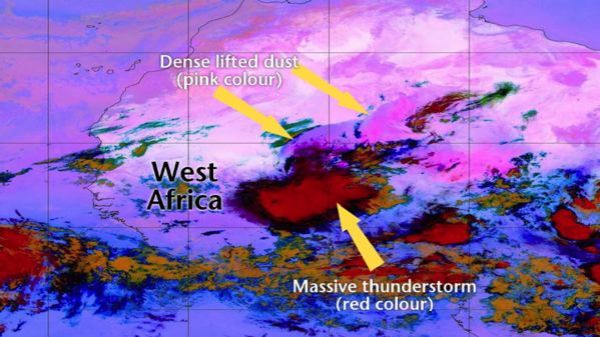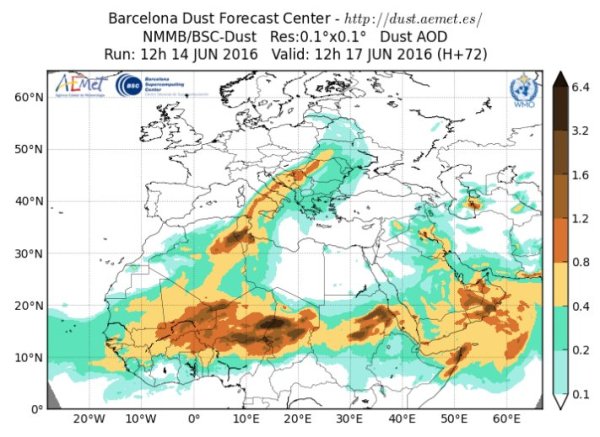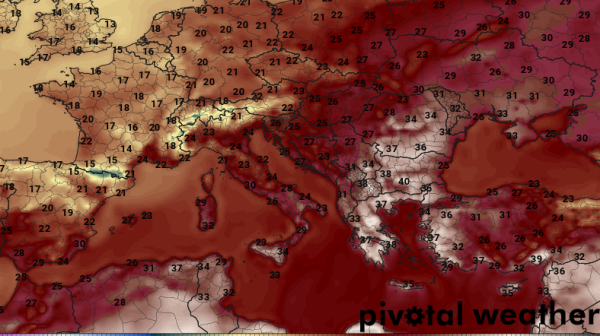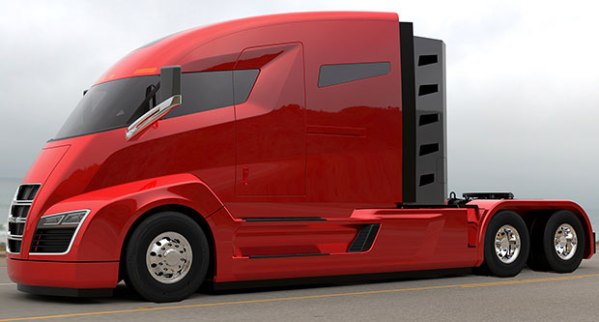Monster African Thunderstorm Hurls Enormous Haboob at Europe, 100 + Degree (F) Heat to Follow
15
June, 2016
An
expansion of the Sahara Desert northward into Europe. A scenario that
has long been a concern raised by scientists modeling potential
extreme weather and climate scenarios related to human-caused climate
change. And this week, it appears that Southern and Eastern Europe
are going to get a taste of Sahara Desert-type weather conditions.
It’s just unfolding a bit more dramatically than scientists at
first anticipated.
(Monster
thunderstorm explodes over Northwestern Africa last night, hurling a
huge dust storm or Haboob northward toward Europe. Image source: The
Met Office.)
Last
night, a massive thunderstorm large enough to cover the England,
Scotland and Ireland combined blew up over western Africa. The storm,
larger than most hurricanes, drew in strong, hot winds from North
Africa and the Sahara Desert. These winds bore upon them a great load
of dust. Dust which the strong outflow of the storm then turned
northward along a frontal boundary draped across the Mediterranean
toward Europe.
As
of early today, a large mass of dust with a front spanning
approximately 600 miles covered sections of Mali, Algeria and Niger
even as strong, hot southerly winds gathered to propel it northward.
Over the next three days, this dust storm, or Haboob, is expected to
rage across North Africa’s Algeria and Tunesia, leap the
Mediterranean, roar across Central Italy, and vent its fury on the
Balkan states and Poland before finally terminating in the Ukraine.
(Large
dust storm is now forecast to cross from North Africa and into
Southeastern Europe. A high amplitude Jet Stream wave pattern and
related strong ridge formation is providing the atmospheric slot that
is propelling the dust further north than is typical. Image
source:Barcelona
Dust Forecast Center.)
From
its origin over Northwest Africa, to its termination over the
Ukraine, this anomalous dust storm is predicted to travel more than
2,500 miles. The storm will be borne by hot southerly winds. Saharan
winds, some could say. And those winds will bring with them not only
the choking dusts of North Africa, but also a taste of its heat.
In
Sofia, Bulgaria, temperatures are expected to hit 95 (F) degrees over
the next few days. In Bucharest, Romania, the mercury is expected to
top 96 by Saturday. Sections of central Bulgaria are likely to see
readings as high as 104 (F) by Saturday. Athens, Greece may reach 102
F temperatures on Saturday and 100 degree (F) temperatures Sunday.
Further up the Balkan Peninsula, Larissa’s forecast is for 107
degree F temperatures by Saturday. All are readings in ranges about
15-20 degree Fahrenheit above average for this European region during
this time of year. Record to near record hot temperatures that have
more in common with typical North African climates than those usually
associated with Southern Europe.
(Dust
storms will travel north along a frontal boundary associated with a
high amplitude wave in the Jet Stream over the next three days. To
the east, sections of Southern and Eastern Europe are expected to
experience record or near record heat. Image source: Pivotal
Weather.
Note, forecast above is in degrees Celsius for Saturday, June 18.)
Very
large thunderstorms do tend to fire now and then over Africa. But the
typical range is more to the south along a band that feeds into the
North Atlantic Inter-tropical Convergence Zone. Over the past day, a
big dip in the Jet Stream has run down from Western Europe and into
North Africa. This dip created atmospheric instability that fueled
the development of the massive thunderstorm and generated the strong
southerly winds that are now propelling the resulting Haboob toward
Europe.
As
has been typical with climate change related high amplitude Jet
Stream waves during recent years, the deep trough over Western Europe
is encouraging a strong dipole associated ridge to form over Eastern
Europe. And it is into this ridge that both the Haboob and the record
heat are now rushing.
Africa-originating
Haboobs and 95 to 107 degree heat blanketing large sections of
Southern and Eastern Europe are not at all typical weather for mid to
late June. But weather extremes associated with human-caused climate
change will tend to make these kinds of North African hot air and
dust storm invasions more and more likely as time progresses.
Links:
Hat
tip to DT Lange
Hat
tip to Spike
To
go with his latest climate report Robertscribbler has come up with
his latest techno-fantasy that is going to save civilisation.
Deluded,
is all I can say
Al Gore’s Revenge — Internal Combustion Engines Stink and This Ridiculously Powerful Electric Turbine Truck Proves It
As
of yesterday, Nikola
Motors announced the performance specs and preorders for its new
hybrid electric long-haul truck.
It’s a ridiculously awesome design — one that boasts across the
board superior performance when compared to internal combustion
engine based trucks that are currently available. The company
producing this amazing feat of electrical hybrid vehicle engineering
calls its new vehicle the Nikola One. But we’re going to have some
fun at the expense of climate change deniers and electric vehicle
detractors both here and call this thing Al Gore’s Revenge.
*****
(Nikola
One aka Al Gore’s Revenge. It’s big, it’s red, it’s mean,
it’s electric — and it’s about to eat internal combustion
engine based trucking market share for lunch. Image source: Nikola
Motor Company.)







Deluded indeed.
ReplyDeleteAnything to keep the Chinese -made salad shooters on the shelves.